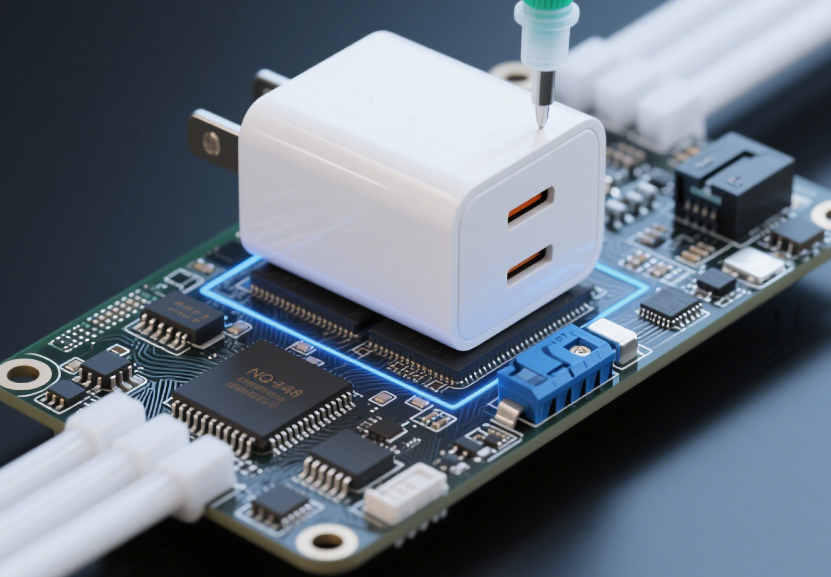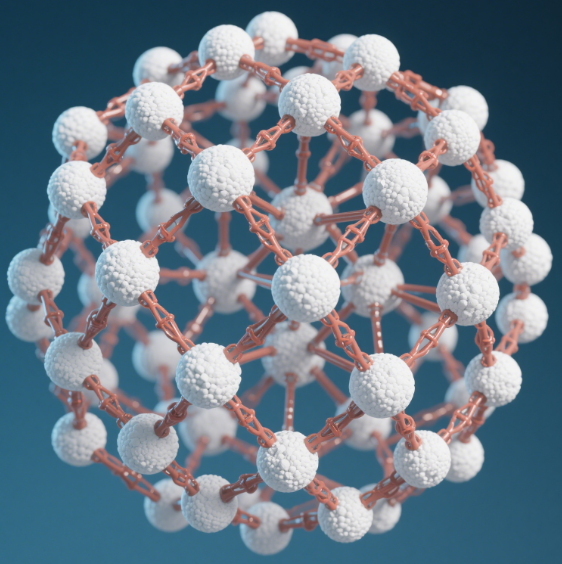Innovative Applications and Challenges of Thermal Conductive Sealants in High-power Electronic Products
2025/04/14
0
In the era of rapid development of modern technology, high-power electronic products such as gallium nitride chargers, 5G base station equipment, and battery management systems of electric vehicles play an increasingly important role in people’s production and daily life. However, with the continuous improvement of the integration and power density of electronic devices, the heat dissipation problem has become a key factor restricting the performance and reliability of high-power electronic products. For example, in 5G base stations, a large number of radio frequency devices and signal processing chips work intensively. If the generated heat cannot be dissipated in a timely manner, it will lead to a decline in equipment performance and even malfunctions, affecting the communication quality.
As a special functional material, thermal conductive sealant has become the core material for solving the thermal management problems of high-power electronic products due to its excellent thermal conductivity, insulation, and sealing properties. It can form a good thermal conduction channel between electronic components and heat sinks, effectively reducing the interfacial thermal resistance and quickly transferring the heat out. At the same time, it can also provide a sealing and protective effect on electronic components, preventing damage caused by external factors such as dust and moisture, and improving the stability and reliability of electronic products. In gallium nitride chargers, the thermal conductive sealant is used for bonding, thermal conduction, and fixing of the chip module, which can effectively control the heating of the chip during charging, reduce the risk of overheating, and also reduce costs.
Currently, with the continuous improvement of market requirements for the performance of high-power electronic products, the research, development, and application of thermal conductive sealants also face new challenges and opportunities. On the one hand, it is necessary to further improve the thermal conductivity, bonding strength, and temperature resistance of thermal conductive sealants to meet the heat dissipation requirements of electronic products with higher power density. On the other hand, attention also needs to be paid to their environmental performance and production costs to achieve an optimized balance between performance and cost. This article will systematically analyze the application advantages, performance requirements, and challenges faced by thermal conductive sealants in high-power electronic products in combination with the industry status and technological progress, aiming to provide a reference for research and application in related fields.
II. Application Advantages of Thermal Conductive Sealants
2.1 Efficient Heat Conduction and Temperature Control
When high-power electronic products are operating, electronic components will continuously generate a large amount of heat. If the heat cannot be dissipated in a timely manner, the temperature of the components will continue to rise, resulting in a decline in performance and even triggering malfunctions. Thermal conductive sealant can fill the tiny gaps between metal parts and the heat dissipation structure, effectively reducing the interfacial thermal resistance, thereby achieving rapid heat transfer.
Taking the power battery of a new energy vehicle as an example, the thermal conductive silicone sheet plays a crucial role in its internal liquid cooling system. During the charging and discharging process of the battery cells, a large amount of heat will be generated. The thermal conductive silicone sheet can efficiently conduct this heat to the liquid cooling pipes, and the coolant in the liquid cooling pipes will then carry away the heat, ensuring that the battery pack can operate stably within a wide temperature range from -55°C to 200°C. Relevant research shows that using a thermal conductive sealant with a thermal conductivity of 3W/(m・K) can reduce the maximum temperature of the battery module by more than 10°C, significantly improving the safety and service life of the battery. In the radio frequency module of a 5G base station, after using a high thermal conductivity sealant, the module temperature can be controlled within a reasonable range, ensuring the stability of signal transmission and reducing the problem of signal interruption caused by overheating.
2.2 Multiple Protection Properties
2.2.1 Electrical Insulation
High-power electronic products often operate in a high-voltage environment and have extremely high requirements for electrical insulation performance. High-quality thermal conductive sealants have a high volume resistivity (≥1.0×10¹⁶ Ω・cm) and dielectric strength (≥17 kV/mm), which can form a reliable insulation barrier between electronic components, effectively preventing electrical short circuits and ensuring the safe operation of the equipment. In switching power supplies, thermal conductive sealants are used to connect power devices and heat sinks, which can not only efficiently conduct heat but also ensure electrical insulation, avoiding safety accidents caused by electric leakage.
2.2.2 Environmental Adaptability
High-power electronic products used in outdoor and humid environments, such as the controllers of wind power generation equipment and outdoor communication base stations, need to have good environmental adaptability. Thermal conductive sealants have excellent ozone resistance, chemical erosion resistance, and moisture resistance, which can effectively resist the erosion of the external environment and extend the service life of the equipment. Research shows that after a 1000-hour salt spray test, the electronic equipment using weather-resistant thermal conductive sealant can still work normally, while the equipment without it has serious corrosion and malfunctions.
2.3 Process Compatibility
In modern large-scale production, process compatibility is an important consideration factor in material selection. Thermal conductive sealants provide single-component or two-component systems and can support automated dispensing processes to meet the needs of different production scenarios. In the production process of mobile phone motherboards, automated dispensing equipment can quickly and accurately apply the thermal conductive sealant between the chip and the heat sink, greatly shortening the production cycle and improving the consistency and reliability of the products.
III. Performance Requirements of High-Power Electronic Products for Thermal Conductive Sealants
3.1 Key Performance Indicators
3.1.1 Thermal Conductivity
Thermal conductivity is a key indicator for measuring the thermal conductivity performance of thermal conductive sealants, which directly determines the ability of the material to conduct heat. In high-power electronic products, such as gallium nitride chargers, the internal gallium nitride chips will generate a large amount of heat during operation. If the heat cannot be dissipated effectively in a timely manner, the chip temperature will rise sharply, leading to a decline in performance or even damage. To meet the heat dissipation requirements of such high-power chips, the thermal conductivity of the thermal conductive sealant needs to be ≥2W/(m・K). A higher thermal conductivity can ensure that the heat is quickly transferred inside the material, reduce the temperature difference between the component and the heat sink, and improve the heat dissipation efficiency. Research shows that when the thermal conductivity of the thermal conductive sealant is increased from 1W/(m・K) to 3W/(m・K), under the same heat dissipation conditions, the operating temperature of the electronic component can be reduced by 15°C – 20°C, effectively improving the stability and reliability of the component.
3.1.2 High Temperature Resistance
High-power electronic products will generate a relatively high amount of heat during operation, which greatly increases the working environment temperature. Therefore, thermal conductive sealants must have excellent high temperature resistance performance to ensure that they can still maintain stable performance in a high temperature environment. Generally speaking, thermal conductive sealants need to withstand a high temperature of more than 200°C for a long time. In some special application scenarios, such as aerospace electronic equipment and high temperature industrial sensors, they even need to withstand the extreme high temperature condition of 300°C. In the electronic control system of an aircraft engine, the ambient temperature around some electronic components during operation can be as high as 250°C – 300°C. This requires that the used thermal conductive sealant can, under such high temperatures, not have problems such as decomposition, aging, and performance degradation, and can continuously and effectively play the roles of heat conduction and sealing.
3.1.3 Mechanical Properties
In high-power electronic products, due to the differences in the thermal expansion coefficients of different materials, thermal stress will be generated when the temperature changes. In order to relieve this thermal stress and avoid damage to the electronic components, the thermal conductive sealant needs to have appropriate mechanical properties. An ideal thermal conductive sealant should have a relatively low hardness (Shore A 55±5) and high elasticity, which can better adapt to the thermal expansion and contraction of the components and reduce stress concentration. In a transformer, a low-hardness and high-elasticity thermal conductive sealant is used to bond and fix the magnetic core and the winding. When the working temperature of the transformer changes, the thermal conductive sealant can buffer the thermal stress through its own elastic deformation, avoiding the cracking of the magnetic core due to excessive stress and ensuring the normal operation of the transformer.
3.2 Reliability Requirements
3.2.1 Thermal Shock Reliability
In the actual use process of high-power electronic products, they often face drastic temperature changes, such as suddenly entering a high temperature environment from a low temperature environment, or vice versa. This thermal shock will pose a severe test to the performance of the thermal conductive sealant. To ensure the reliability of the material under complex temperature change conditions, a thermal shock test is required. The test usually requires the thermal conductive sealant to undergo multiple cycles within the temperature range of -45°C to 120°C to check its performance stability under extreme temperature changes. After 1000 cycles of the thermal shock test, the thermal conductivity and bonding strength of a certain brand of thermal conductive potting compound have no significant attenuation, showing excellent thermal shock reliability, which can provide a strong guarantee for the stable operation of high-power electronic products in harsh temperature environments.
3.2.2 Vibration Aging Reliability
In some application scenarios, such as the bumps during the driving of an electric vehicle and the vibration of industrial equipment, high-power electronic products will be affected by continuous vibration. This requires that the thermal conductive sealant can still maintain good performance in a vibration environment and avoid problems such as bonding failure and decline in thermal conductivity performance caused by vibration. The reliability of the thermal conductive sealant under vibration conditions can be evaluated through a vibration aging test. In the vibration aging test, the vibration frequency and amplitude in the actual working process are simulated, and the electronic components using the thermal conductive sealant are subjected to a long-term vibration test. The results show that high-quality thermal conductive sealants can still maintain stable thermal conductivity performance and bonding strength after a long-term vibration aging test, ensuring the reliable connection and effective heat dissipation of the electronic components in a vibration environment.
IV. Technical Challenges and Solutions
4.1 Industry Pain Points
In the heat dissipation applications of high-power electronic products, traditional thermal conductive sealants have exposed some key problems, which limit their further application in high-performance electronic products.
The problem of internal stress is a major challenge faced by traditional potting compounds. Traditional potting compounds often have a relatively high shrinkage rate during the curing process, which will generate a large amount of internal stress inside the electronic components. Taking the condensation type silicone potting compound as an example, its curing shrinkage rate is usually between 1% – 3%. Such a large shrinkage rate may cause the components to deform, and even lead to serious problems such as solder joint cracking and chip failure. In an integrated circuit, when the traditional potting compound is used to encapsulate between the chip and the substrate, due to the internal stress generated by the curing shrinkage, the connection solder joints between the chip and the substrate may be subjected to additional tensile force. Under the long-term action, the solder joints are prone to fatigue cracks, and ultimately lead to the failure of the electrical connection, affecting the normal operation of the entire circuit.
In addition, process limitations also bring troubles to the application of thermal conductive sealants. With the development of miniaturization and precision of electronic products, the requirements for the potting process are getting higher and higher. However, some thermal conductive sealant materials with high viscosity are difficult to meet the needs of precision potting. The potting compound with high viscosity has poor fluidity during the potting process, is difficult to fill into tiny gaps and complex structures, and is likely to have uneven potting, which in turn affects the uniformity of heat dissipation. In the potting process of the mobile phone motherboard, if the viscosity of the potting compound is not appropriate, it may not be able to completely fill the tiny gaps between the chip and the heat sink, resulting in an increase in local thermal resistance, and the heat cannot be effectively transferred, affecting the heat dissipation performance and stability of the mobile phone.
4.2 Innovative Breakthroughs
In order to deal with the above challenges, a series of technological innovations have been carried out in the industry, achieving remarkable breakthroughs.
In terms of solving the internal stress problem, the low-stress formula has become the key technology. The thermal conductive sealant using the addition type silicone system shows unique advantages, and its shrinkage rate can be controlled to be <0.1%. Taking the NQ – 958 – 20 series products as an example, the internal stress is effectively reduced by optimizing the cross-linking density. The cross-linking density is an important factor affecting the internal stress of the material. This series of products makes the cross-linking density reach the optimal state by precisely controlling the dosage of the cross-linking agent and the reaction conditions, thus minimizing the internal stress generated by the curing shrinkage while ensuring the performance of the material. In practical applications, the NQ – 958 – 20 series thermal conductive sealant is used for the potting of high-power LED chips, successfully solving the problem of chip damage caused by the internal stress of the traditional potting compound, greatly improving the reliability and service life of the LED chips.
In terms of process compatibility, the intelligent process compatibility technology provides a new solution for the application of high-viscosity materials. The Dow potting compound realizes good support for the large-flow and high-speed dispensing process through innovative anti-sedimentation design. The anti-sedimentation design mainly makes the potting compound maintain a uniform dispersion state during the storage and use process through the selection and treatment of the filler and the optimization of the formula, avoiding the sedimentation of the filler. In the production of the battery module of an electric vehicle, the Dow potting compound can meet the large-flow and high-speed dispensing requirements of the automated production line, not only improving the production efficiency but also enhancing the consistency and stability of the potting, effectively improving the uniformity of heat dissipation, and improving the performance and reliability of the battery module.
V. Typical Application Cases
5.2 Gallium Nitride Chargers
With the continuous growth of the portability requirements of electronic devices, gallium nitride (GaN) chargers have quickly become the focus of the market due to their advantages of high power density and miniaturization. In this type of charger, the application of thermal conductive sealant is crucial.
Taking a certain brand’s 65W gallium nitride charger as an example, the Yusheng thermal conductive adhesive is used inside it. This adhesive achieves a thermal conductivity of 2W/(m・K) in the GaN chip module and at the same time meets the IP67 waterproof rating. This application makes the temperature rise of the charger decrease by 15°C while the volume is reduced by 40%. In actual use, when this charger charges a laptop, even if it operates at high power for a long time, the surface temperature of the charger still remains at a relatively low level, effectively avoiding the risks of a decline in charging efficiency and equipment damage caused by overheating. This not only improves the user experience but also extends the service life of the charger.
From a technical principle perspective, the Yusheng thermal conductive adhesive can closely fit the GaN chip and the heat sink, forming an efficient thermal conduction channel and quickly transferring the heat generated by the chip out. Its characteristic of meeting the IP67 waterproof rating effectively prevents water from entering the inside of the charger, avoiding malfunctions caused by problems such as short circuits, and ensuring the stable operation of the charger in various environments. In the production process, the good fluidity and curing characteristics of this thermal conductive adhesive enable it to achieve precise coating on the automated production line, improving the production efficiency and the consistency of product quality.
VI. Future Prospects
With the continuous development of high-power electronic products towards high power density, miniaturization, and multifunctionality, higher requirements are put forward for the performance and application of thermal conductive sealants. The future development will focus on multiple key directions such as material innovation, intelligent response design, and environmental protection trends.
In terms of material innovation, the research and development of new thermal conductive fillers is the core path to improve the performance of thermal conductive sealants. Traditional single thermal conductive fillers have bottlenecks in improving thermal conductivity performance and are difficult to meet the heat dissipation requirements of the next generation of high-power electronic products. The thermal conductive filler formed by the composite of diamond micro powder and graphene shows great potential. Diamond micro powder has an extremely high thermal conductivity, while graphene has excellent two-dimensional planar thermal conductivity characteristics and good flexibility. The combination of the two can complement each other’s advantages. Through advanced processes such as chemical vapor deposition (CVD), precisely controlling the growth and distribution of diamond micro powder on the graphene sheets, it is expected to develop a high-performance thermal conductive sealant with a thermal conductivity exceeding 3.0W/(m・K). When this new type of thermal conductive sealant is applied in the next generation of radio frequency chips of 5G base stations, it can further reduce the chip operating temperature, improve the signal processing speed and stability, and meet the growing requirements of 5G networks for high speed and low latency.
Intelligent response design is also an important development trend of thermal conductive sealants in the future. With the continuous change of the load of high-power electronic products, the fixed thermal resistance of traditional thermal conductive sealants cannot dynamically adapt to temperature fluctuations. Integrating phase change materials into thermal conductive sealants can achieve dynamic adjustment of thermal resistance. When the power of the electronic product increases and the temperature rises, the phase change material absorbs heat and undergoes a phase change, increasing the thermal conductivity and quickly dissipating heat. When the temperature decreases, the phase change material returns to its original state and maintains stable thermal performance. During the fast charging process of an electric vehicle, the temperature of the battery module will rise sharply. The thermal conductive sealant integrated with the phase change material can respond to the temperature change in a timely manner, effectively control the battery temperature, and improve the charging efficiency and battery life. By introducing intelligent sensors and microprocessors, the real-time monitoring and precise control of the thermal performance of the thermal conductive sealant can be realized, further improving its adaptability and reliability under complex working conditions.
The environmental protection trend cannot be ignored in the future development of thermal conductive sealants. With the continuous increase of global attention to environmental protection, the environmental protection regulations for electronic product materials in various countries are becoming increasingly strict. For example, the EU’s REACH and RoHS directives have more stringent restrictions on hazardous substances. Promoting the thermal conductive sealants with solvent-free and low VOC (volatile organic compounds) formulas has become an inevitable trend. Using water-based systems or solid resins to replace traditional organic solvents can significantly reduce the emission of volatile organic compounds and reduce the harm to the environment and the human body. By optimizing the synthesis process and raw material selection, ensuring that the thermal conductive sealant meets strict environmental protection standards while meeting high-performance requirements, realizing green manufacturing. In the large-scale production of electronic devices, using environmentally friendly thermal conductive sealants not only helps enterprises meet regulatory requirements but also improves the market competitiveness of products, promoting the entire industry to move towards sustainable development.
Through functional integration and process optimization, thermal conductive sealants have become the core materials for the thermal managementv

















